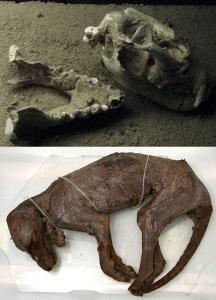 We’ve just published an analysis of new radiocarbon dates showing that thylacines (Tasmanian ‘tigers’, Thylacinus cynocephalus) and Tasmanian devils (Sarcophilus harrisi) went extinct on the Australian mainland at the same time — some 3200 years ago.
We’ve just published an analysis of new radiocarbon dates showing that thylacines (Tasmanian ‘tigers’, Thylacinus cynocephalus) and Tasmanian devils (Sarcophilus harrisi) went extinct on the Australian mainland at the same time — some 3200 years ago.
For many years, we’ve been uncertain about when thylacines and devils went extinct in mainland Australia (of course, devils are still in Tasmania, and thylacines went extinct there in the 1930s) — a recent age for the devil extinction (500 years before present) has recently been shown to be unreliable. The next youngest reliable devil fossil is 25000 years old.
So, knowing when both species went extinct is essential to be able to determine the drivers of these extinctions, and why they survived in Tasmania. If the two extinctions on the mainland happened at the same time, this would support the hypothesis that a common driver (or set of drivers) caused both species to go extinct.
We (Lauren White, Frédérik Saltré, me, and Jeremy Austin) used new, high-quality radiocarbon dates from thylacine and devil fossil bones from across southern Australia and statistical techniques to estimate the timing of extinction for both species on the mainland. These new dates include the youngest fossil samples ever found for both species (3245 years before present for the devil, and 3290 years before present for the thylacine).
A synchronous extinction of these species has almost always been assumed, but this is the first time that we have both a reliable dataset and robust statistical technique to validate this assumption.
The new, reliable dates show that both species went extinct on the mainland at almost exactly the same time: 3200 years ago (plus or minus 50 years). This suggests that a common driver was responsible for the mainland extinctions.
While we haven’t yet been able to identify which drivers were the most likely mechanisms of extinction for these species, we now have a strong and defendable basis (i.e., a high-quality, reliable dataset and a robust method) on which further research can build.
CJA Bradshaw

